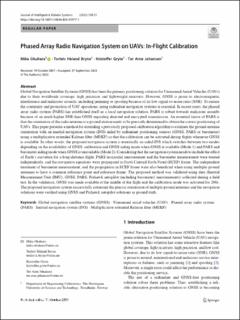| dc.contributor.author | Okuhara, Mika | |
| dc.contributor.author | Bryne, Torleiv Håland | |
| dc.contributor.author | Gryte, Kristoffer | |
| dc.contributor.author | Johansen, Tor Arne | |
| dc.date.accessioned | 2023-11-06T09:42:40Z | |
| dc.date.available | 2023-11-06T09:42:40Z | |
| dc.date.created | 2022-10-17T16:10:33Z | |
| dc.date.issued | 2022 | |
| dc.identifier.issn | 0921-0296 | |
| dc.identifier.uri | https://hdl.handle.net/11250/3100723 | |
| dc.description.abstract | Global Navigation Satellite Systems (GNSS) has been the primary positioning solution for Unmanned Aerial Vehicles (UAVs) due to their worldwide coverage, high precision and lightweight receivers. However, GNSS is prone to electromagnetic interference and malicious assaults, including jamming or spoofing because of its low signal-to-noise ratio (SNR). To ensure the continuity and protection of UAV operations, using redundant navigation systems is essential. In recent years, the phased array radio system (PARS) has established itself as a local navigation solution. PARS is robust towards malicious assaults because of a much higher SNR than GNSS regarding directed and encrypted transmission. An essential factor of PARS is that the orientation of the radio antenna at a ground station needs to be precisely determined to obtain the correct positioning of UAVs. This paper presents a method for extending a previously proposed calibration algorithm to estimate the ground antenna orientation with an inertial navigation system (INS) aided by redundant positioning sensors (GNSS, PARS or barometer) using a multiplicative extended Kalman filter (MEKF) so that the calibration can be activated during flights whenever GNSS is available. In other words, the proposed navigation system is essentially an aided-INS which switches between two modes depending on the availability of GNSS: calibration and GNSS aiding mode when GNSS is available (Mode 1) and PARS and barometer aiding mode when GNSS is unavailable (Mode 2). Considering that the navigation system needs to include the effect of Earth's curvature for a long-distance flight, PARS horizontal measurement and the barometer measurement were treated independently, and the navigation equations were propagated in Earth Centred Earth Fixed (ECEF) frame. The independent treatment of barometer measurement and the propagation in the ECEF frame were also beneficial when using multiple ground antennas to have a common reference point and reference frame. The proposed method was validated using data (Inertial Measurement Unit (IMU), GNSS, PARS, Pixhawk autopilot (including barometer) measurements) collected during a field test. In the validation, GNSS was made available in the middle of the flight and the calibration mode was activated for 200s. The proposed navigation system successfully estimated the precise orientation of multiple ground antennas and the navigation solutions were verified using GNSS and Pixhawk autopilot solutions as ground truth. | en_US |
| dc.description.abstract | Phased Array Radio Navigation System on UAVs: In-flight Calibration | en_US |
| dc.language.iso | eng | en_US |
| dc.publisher | Springer | en_US |
| dc.rights | Navngivelse 4.0 Internasjonal | * |
| dc.rights.uri | http://creativecommons.org/licenses/by/4.0/deed.no | * |
| dc.title | Phased Array Radio Navigation System on UAVs: In-flight Calibration | en_US |
| dc.title.alternative | Phased Array Radio Navigation System on UAVs: In-flight Calibration | en_US |
| dc.type | Peer reviewed | en_US |
| dc.type | Journal article | en_US |
| dc.description.version | publishedVersion | en_US |
| dc.source.journal | Journal of Intelligent and Robotic Systems | en_US |
| dc.identifier.doi | https://doi.org/10.1007/s10846-023-01977-1 | |
| dc.identifier.cristin | 2062149 | |
| dc.relation.project | Norges forskningsråd: 309370 | en_US |
| cristin.ispublished | false | |
| cristin.fulltext | postprint | |
| cristin.qualitycode | 1 | |

